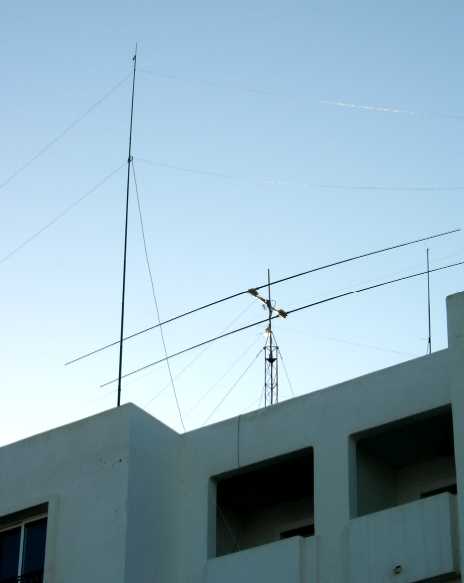 After testing the concept last year in the ARRL-DX from home (see http://f6irf.blogspot.com/2006/02/low-cost-2-elements-for-40m.html ) I designed a new antenna, especialy for the ARRL-DX from CN2WW. The terrasse dimensions, limiting us to 8m spacing, I used a director rather than the classical reflector. The drawing shows the 2 beams (40 and 80) using the same supports. Obviously with a such a reduced spacing (0.1 wl), the antenna cannot be designed for z=50 while giving satisfactory performances, but using a UNUN provides a perfect and broadband match, with very low losses (The steppIR uses the same type of broadband matching device). The multi-UNUN based on a W2FMI design and commercialized by CWSbytemark ( http://www.cwsbytemark.com/ ) offers an easy and flexible solution. A second unit allowed the 40 beam to be designed for max gain, with impedance around 36 ohms. The only difference is that the 40m UNUN was placed after a 1/2wl of cable, and not directly at the feed point ( the 40m dipole being on a fiber mast). The following graphs show the performances of the 80m aerial.
After testing the concept last year in the ARRL-DX from home (see http://f6irf.blogspot.com/2006/02/low-cost-2-elements-for-40m.html ) I designed a new antenna, especialy for the ARRL-DX from CN2WW. The terrasse dimensions, limiting us to 8m spacing, I used a director rather than the classical reflector. The drawing shows the 2 beams (40 and 80) using the same supports. Obviously with a such a reduced spacing (0.1 wl), the antenna cannot be designed for z=50 while giving satisfactory performances, but using a UNUN provides a perfect and broadband match, with very low losses (The steppIR uses the same type of broadband matching device). The multi-UNUN based on a W2FMI design and commercialized by CWSbytemark ( http://www.cwsbytemark.com/ ) offers an easy and flexible solution. A second unit allowed the 40 beam to be designed for max gain, with impedance around 36 ohms. The only difference is that the 40m UNUN was placed after a 1/2wl of cable, and not directly at the feed point ( the 40m dipole being on a fiber mast). The following graphs show the performances of the 80m aerial.

 The bandwith was the main concern, but as shown by the graphs most of CW-contest band is usable with SWR below 2. Although I have full confidence in computer simulation, the results obtained with this aerial during the ARRL-DX really surprised me. see http://lists.contesting.com/archives//html/3830/2007-02/msg01551.html ). I believe that on top o f the 3.5dBd gain its main quality has been to protect us from the heavy EU-QRM.
The bandwith was the main concern, but as shown by the graphs most of CW-contest band is usable with SWR below 2. Although I have full confidence in computer simulation, the results obtained with this aerial during the ARRL-DX really surprised me. see http://lists.contesting.com/archives//html/3830/2007-02/msg01551.html ). I believe that on top o f the 3.5dBd gain its main quality has been to protect us from the heavy EU-QRM.  View of the aerials installed at CN2WW, the fiber mast supports the 40m dipole and the 80m director while the tower supports the 40m reflector and the 80m dipole.
View of the aerials installed at CN2WW, the fiber mast supports the 40m dipole and the 80m director while the tower supports the 40m reflector and the 80m dipole. As information the dimensions provided by the computer model are the following one: For 8m spacing and a center angle of 120 degrees, the half-dipole is 21.18m and the half-director 20.6m. But of course the dimension may vary, fonction of the height, the angle, the environment, the wire used (i.e. plastic coated wire has a velocity factor in the order of 0.95), so it is strongly recommended to adjust the dipole alone first below the desired frequency (removing the director on the computer model gives 3.465 for jX=0) Then place the director and cut it until the desired frequency is obtained (3.532 for jX=0 ). I think that it is the best way to get the aerial working as expected.
Computer models (MMANA or NEC2) can be provided on request.
No comments:
Post a Comment